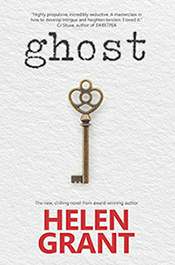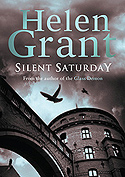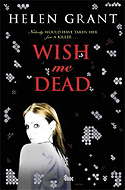The Glass Demon is my second novel, published a year after The Vanishing of Katharina Linden. Like my first book, it is set in the rural Eifel region of Germany. It isn't set right in Bad Münstereifel this time, but the town is mentioned several times.
What's it about?
The heroine of The Glass Demon is 17-year-old Lin Fox, whose father Dr. Oliver Fox is a university don working in mediaeval studies. Oliver Fox is good-looking (George Clooney comparisons are made) and has rather an ego, so when he fails to get a professorship he wants, he is looking for excuse to get away from the university for a while. Dr. Fox has received a letter from a local historian in a town called Baumgarten, claiming that he knows the location of the missing stained glass windows of Allerheiligen Abbey. These windows are a kind of "Holy Grail" for mediaevalists; they are also rumoured to be haunted by the demon Bonschariant, who can be seen looking through the glass, with fatal results for anyone who sees him.
Oliver decides to move the entire family over to Germany to hunt for them, the entire family being: himself, his vain and impractical wife Tuesday, Lin, her sister Polly and their baby brother Ru. Shortly after their arrival in Germany, however, Dr. Fox and Lin find that the historian who wrote the letter has died under mysterious circumstances - and broken glass was discovered at the scene. Was the death an accident, murder, or could it possibly be the work of the demon Bonschariant?
So is it a real person or is it the demon?
I'm not telling you that.
Where did you get the idea for the book?
I got the idea from the fascinating real-life history of the Steinfeld Abbey stained glass windows. You can read all about that in a previous blog post entitled Lingering memories of the treasure. The Steinfeld glass - like the fictional Allerheiligen glass in the book - dates to the 16th century. A number of times during its history it was removed from the abbey windows for its own protection, and then at the beginning of the nineteenth century when the abbey was closed, it vanished altogether. A century later, the famous English ghost story writer M.R.James identified a large number of panels from Steinfeld in the windows of Ashridge House chapel, which he was cataloguing for Lord Brownlow. The windows inspired M.R.James to write The Treasure of Abbot Thomas.
Two things about the Steinfeld glass interested me very much. Firstly, I was amazed that it was even possible to remove stained glass from the window frames and transfer it to another church without smashing it all to smithereens. Secondly, given that the Steinfeld glass was auctioned in the 1920s for the equivalent of about £800,000 in modern money, if another comparable set of windows were to be discovered now, they would probably be worth £1,000,000. Their rarity and value would be excellent reasons for Dr. Fox to want to find them, and for other people to want to stop him...
And the demon? Did you make him up?
No - there really is a local Eifel legend about the demon Bonschariant. It's connected with Steinfeld Abbey. Count Sigebodo (love that name!), who built the abbey, is supposed to have had a mysterious servant named Bonschariant ("the good servant") who was actually a demon. The count turned a blind eye to Bonschariant's demonic aspects for a long time because he was such a useful person to have around - he once flew into the air during a battle carrying the count with him to save him from being killed. But eventually the count's wife became frightened and encouraged the count to get rid of Bonschariant. The count built the abbey and fixed a cross to the highest point - when Bonschariant saw the cross he flew away snarling and was never seen again.
Above: the Norwegian cover.
So Lin (who is 17) is the heroine...is it a teen book, then?
It's suitable for anyone over about 14 (admittedly I was reading much gorier stuff when I was younger than that, cough). In some countries it was actually sold as an adult title, and a large proportion of the readers to date have been adults. There are some cryptic M.R.James references in the text that only fellow fans of MRJ would "get", and most of the people who have picked up on those so far have been adults!
Are the places in the book real ones?
Yes, but unlike the places in The Vanishing of Katharina Linden, I renamed most of them. Some real place names are used: Bad Münstereifel, Köln. But Baumgarten, Nordkirchen and Traubenheim are all made up. This is because much of the action is set in a castle. There are many castles in the Eifel and some are still in private hands or are actually inhabited. I didn't want anyone to think that I was writing about their home and perhaps be offended, so I decided to give the locations fictional names, and I combined elements from several different castles to be on the safe side.
Did the book win anything?
It didn't win anything but it was nominated for the CILIP Carnegie Medal 2011 and shortlisted for the Leeds Book Awards 2011. The US edition was shortlisted for the International Thriller Writers Awards 2012, category: Best paperback original.
What did the critics think?
"For teenage readers, Helen Grant's second novel, The Glass Demon, is told from the point of view of a modern-day teenage girl temporarily and unwillingly relocated to a German forest while her image-obsessed, university-teacher father does research into some missing medieval stained glass. Witty instead of facetious, occasionally scary without seeming merely silly, well-plotted and beautifully written, it is everything a young-adult novel should be. Helen, please keep on writing."
—The Independent
"Helen Grant's publisher is marketing her as "the Stieg Larsson of teen fiction", but don't let that put you off. Grant is an original, accomplished author in her own right and with The Glass Demon, her second novel, she brings us a gripping and atmospheric adventure, involving murder, family break-up, chilling folklore and warped religion.
The story centres on 17-year-old Lin, the daughter of a failed academic who drags his entire family from their home in an English university town to rural Germany in search of some missing medieval stained glass he believes will make his name and his fortune. The glass is said to be haunted by a demon who will punish any efforts to remove it from its hiding place. As soon as the family arrives, a spate of gruesome murders begins, with the bodies always surrounded by shards of broken glass.
There are shades of Larsson in the way the murderer takes his cue from biblical stories, but the dark, chilling mood is really closer to the Brothers Grimm. Grant builds the suspense cleverly, maintaining the tension with a light touch, and Lin is an appealingly spunky narrator. It is barely a year since this author's impressive debut, The Vanishing of Katharina Linden, earmarked her as a writer to watch, and this follow-up will consolidate her reputation as a talented new author."
—The Guardian
"Helen Grant's wonderful debut, The Vanishing of Katharina Linden, has just been shortlisted for the Carnegie Medal. This second novel confirms what a talented writer she is. It is a compelling mystery about an English family staying in a grim house in German woods, and the search for some stained-glass windows from which an evil demon is said to spring. A series of deaths and threatening events fill the reader and the 17-year-old narrator, Lin, with foreboding. An atmosphere of mounting unease builds to a terrifying climax and, along with Lin, we are drawn towards believing the unbelievable. The novel is knowledgeable about German Life, and well observed about unrequited fancying and family relationships: the vain father, shallow stepmother, sweet, self-destructive sister and baby brother are all memorable and persuasive. This book is both painful and sometimes blackly funny. Grant handles place, people and red herrings with originality and precision."
—The Sunday Times (Children's Book of the Week)
And in the interests of taking the rough with the smooth, I should add this from a 3-star Amazon review: "Possibly the only reason why I didn't rate this higher is because of the cliché of the ruined castle in the German forest..."
That particular comment has stuck in my mind because the setting had not struck me as a cliché at all - because it was inspired by a real place! I suppose on reflection the "creepy old castle" is a bit of a cliché. But there are a great many of those clichés all over that part of Germany...Ah well.
Above: the Dutch cover.
Anything else we should know about this book?
It's one of my personal favourites out of everything I have written. This is partly because of the connection to M.R.James, whose work I love - I had always fancied writing something that was a bit of a tribute to him. He and Father Nikola Reinartz, a German priest who corresponded with him and whose articles about the glass I have read with interest, are both mentioned in the acknowledgements at the back of the book. The other reason I loved working on this book is that I really love the characters. Oliver and Tuesday are such awful parents - it's so much more fun writing dreadful characters than goody-goody ones! And I really love Michel, the local boy who helps Lin in her investigations. After I'd finished writing The Glass Demon, I slept with the manuscript by my bed for months. I didn't want to let go of it!











I loved the awful narcissistic parents so much, especially Tuesday!
ReplyDeleteHeh! Yes...horrible characters are so much more fun to write than angelic ones, aren't they?!
ReplyDelete